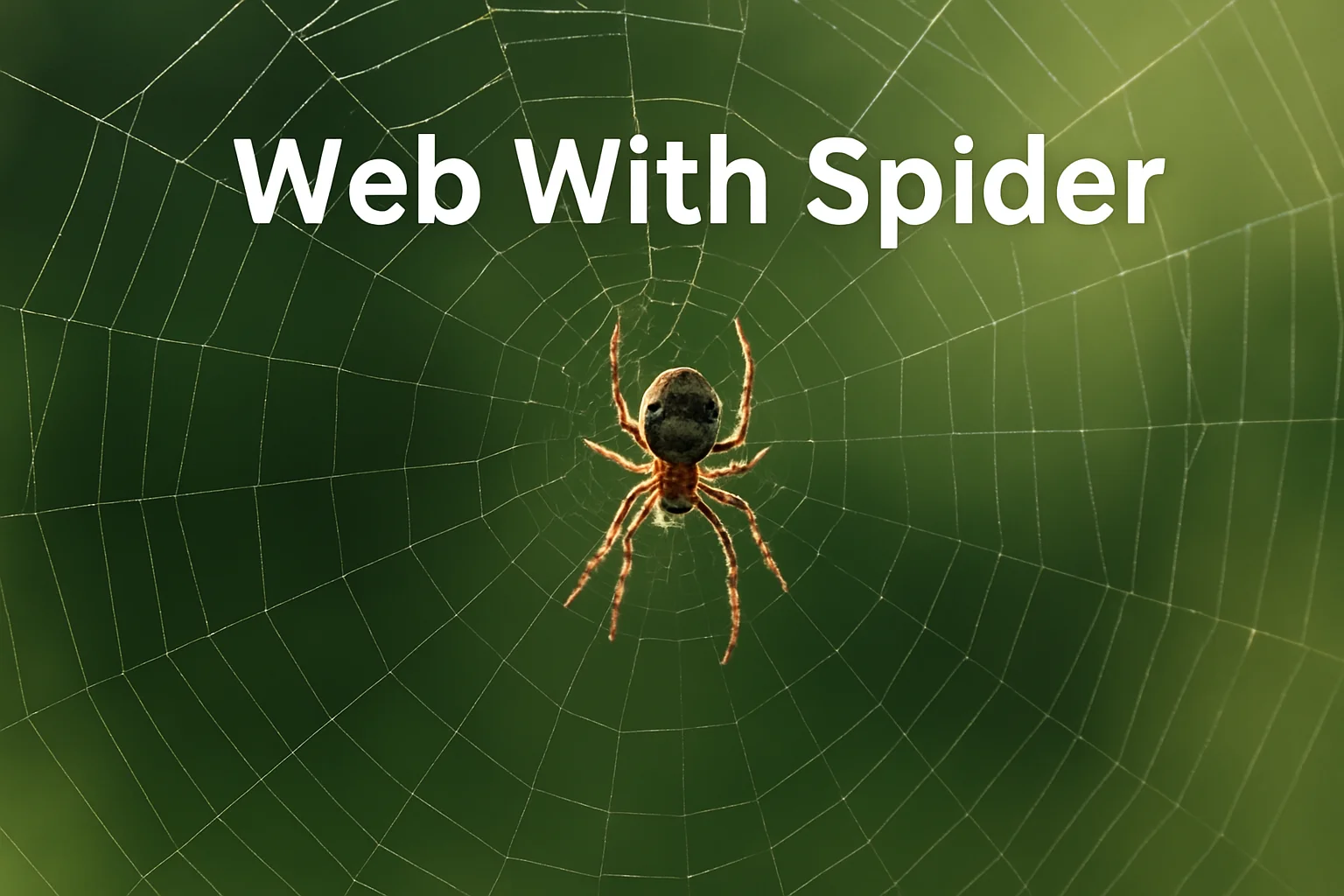Introduction
When people search for web with spider, they can mean many different things. Some want to buy Halloween decorations. Others want to learn how real spiders create their webs. A few even use the term in a technical sense — talking about how search engines use “spiders” to crawl the web. This simple phrase connects nature, design, and technology in fascinating ways.
In this article, we’ll explore every side of web with spider — from decorations and biology to digital web crawling. You’ll learn what it means, why people search for it, and how it plays a role in both real and virtual worlds.
“Web With Spider” as a Decoration or Product
When you first hear web with spider, your mind might jump to Halloween. That’s because fake spider webs with plastic spiders are among the most popular Halloween decorations. They’re simple, spooky, and easy to use.
What Is a “Web With Spider” Decoration?
A “web with spider” decoration is a synthetic web — often made of polyester or cotton fibers — designed to look like a real spider web. These decorations usually come with small plastic or rubber spiders attached. They can be stretched over windows, walls, or outdoor bushes to create an eerie effect.
People use these decorations not just for Halloween but also for themed parties, haunted houses, and photography sets. The best ones look almost real, especially when stretched thin under dim light or fog.
Types and Where to Buy
There are many types of web with spider decorations. Some come as large nets for outdoor setups, while others are fine, stretchable strands for indoor decor. You can find them on sites like Amazon, Home Depot, or Michaels. Many packs include multiple fake spiders and glow-in-the-dark features.
If you prefer DIY, you can make your own web using cotton batting, string, or yarn. Add a few plastic spiders from a craft store, and you’ll have your own spooky masterpiece.
Installation and Tips
When setting up a spider web decoration:
- Stretch the fibers evenly for a natural look.
- Secure the edges with tape, tacks, or hooks.
- Add lighting to highlight the web’s texture.
- For outdoor use, choose weather-resistant material.
Avoid overstuffing the web — sparse, delicate patterns look more realistic. After your event, gently remove the web and store it for future use.
The Biology Behind Real Spider Webs
Of course, the real web with spider is a masterpiece of nature. Spiders have been weaving webs for millions of years, and each design serves a specific purpose.
How Spiders Build Their Webs
Spiders produce silk from special glands called spinnerets. Depending on the type of spider, this silk can be sticky or dry. The process begins when the spider releases a thin strand of silk into the air. As it drifts and attaches to a surface, the spider crosses back and forth, creating the foundation of its web.
From there, it builds spokes outward, forming a circular pattern. Then it adds sticky spiral lines that help trap insects. The finished product is both lightweight and incredibly strong — gram for gram, spider silk is stronger than steel.
Types of Spider Webs
Different spiders make different kinds of webs. The orb web is the most common and is what most people imagine when they think of a web with spider. Other types include:
- Sheet webs: flat layers often built by small house spiders.
- Funnel webs: cone-shaped webs leading to a spider’s hiding spot.
- Cobwebs: messy, tangled webs made by common house spiders.
Each design suits the spider’s hunting style and environment.
Why Spiders Rebuild Their Webs
Many spiders take down and eat their webs daily. The silk contains protein, so reusing it saves energy. Some even recycle the web by wrapping it into a small ball before digesting it. This constant rebuilding helps keep the web sticky and effective for catching prey.
Symbolism and Cultural Meaning
Across cultures, the spider web symbolizes creativity, patience, and destiny. In Native American mythology, the “Spider Woman” weaves the web of life. In African folklore, the spider Anansi is a clever trickster. Some people even get tattoos of a web with spider as a symbol of resilience and creation.
“Web With Spider” in Technology and SEO
The digital world also uses the term web with spider, but here it has a very different meaning. In computing, a “spider” is not an insect — it’s a software program that “crawls” websites to collect data.
What Is a Web Spider or Crawler?
A web spider (or crawler) is an automated program that browses the internet, visiting websites and indexing their content. Google, Bing, and other search engines use these spiders to discover and rank web pages.
When you publish a new article or product page, these spiders find it through links or sitemaps. They read the text, analyze structure, and decide how relevant it is for specific keywords. This process allows search engines to show your content to the right audience.
How Web Spiders Work
- Crawling: The spider starts with a list of URLs. It visits each one, scans the content, and finds links to other pages.
- Indexing: It stores the information in a giant database called an index.
- Ranking: When someone searches, the engine retrieves the most relevant pages from the index.
These web spiders help organize the internet’s massive content, making search possible.
SEO Tools That Use Spiders
Some SEO tools — like Screaming Frog SEO Spider or Sitebulb — use crawler technology to audit websites. They find broken links, duplicate pages, and SEO issues. If you run a website, using a crawler helps you see your site the way Google does.
How to Make Your Website Spider-Friendly
To help web spiders understand your site:
- Keep URLs clean and descriptive.
- Use internal links so spiders can navigate your pages.
- Add structured data (schema markup).
- Create an XML sitemap and submit it to search engines.
- Avoid blocking important pages in your robots.txt file.
A “healthy web with spider” relationship ensures that your site is fully visible online.
The Connection Between Nature and Technology
It’s fascinating how both real and digital spiders weave networks. In nature, the web connects creatures through survival. In technology, the web connects people through information. Both rely on structure, patience, and purpose.
A spider spins its web thread by thread. Similarly, the internet grows link by link. Just as spiders maintain their webs daily, web developers and SEOs maintain websites for performance and visibility.
This comparison shows why “web” and “spider” are such fitting terms for both biology and technology.
Frequently Asked Questions (FAQs)
Q1. What does “web with spider” mean?
It can mean a decorative item, a natural spider web, or a technical term for web crawlers in SEO.
Q2. How do spiders make their webs?
They use silk from spinnerets, building circular or funnel-shaped structures to catch prey.
Q3. Where can I buy a fake web with spider?
You can find them online at Amazon, Home Depot, or craft stores during Halloween season.
Q4. What is a web spider in SEO?
It’s an automated program that crawls websites and indexes their content for search engines.
Q5. Can spiders reuse their webs?
Yes, some spiders eat or rebuild their webs daily to recycle the silk.
Summary and Conclusion
The phrase web with spider connects worlds that seem completely different — art, nature, and technology. In decorations, it brings spooky joy to Halloween lovers. In biology, it represents a marvel of natural engineering. In the digital world, it powers how search engines explore and organize the internet.
Whether you’re buying a Halloween prop, learning about real spider silk, or optimizing your website, understanding the concept of a web with spider adds meaning to what you do. From the threads of silk to the lines of code, everything begins with a web — and a spider that brings it to life.


